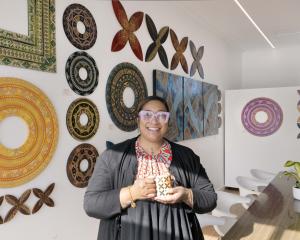Two very different approaches to landscape painting will be shown in Dunedin in coming weeks. Rebecca Fox talks to Phillip Edwards about his work.
Phillip Edwards hates the term ''photorealism'', yet looking at his work you cannot help but marvel at the detail.
The detail is what his subjects - mostly involving water but occasionally buildings filter through - require, the Dunedin artist said.
''You can't improve on nature and I'm not trying to.''
Coming from an artistic family (his father was a commercial artist and his mother a watercolour painter), it was not surprising Mr Edwards tended towards art.
''I drifted into it after school. I'm largely self-taught with help from Dad.''
His work sold in galleries in Auckland but when the family moved to Nelson after his father Henry died, he decided to take a break from art.
''I was the Nelson Library bookbinder for 17 years.''
Then seven years ago he and his partner moved down to Dunedin and he started to paint again, this time with water a strong theme.
''It's a very challenging thing water. It's tough, it stretches you. I've not quite conquered it.''
• Rebecca Fox talks to Jenna Packer
While in his very early career he was heavily influenced by overseas artists' work which he really admired, he found he was going his own way now.
''You can't help but pick up experiences as you go. You find your own style the more you do.''
In his early days his work was very ''up close'' and he did a lot of still life but now he did more landscapes.
''Maybe my technique has developed to the stage I can handle it.''
His work, while detailed, was not photorealism, as he liked to add a ''little bit of texture or painterly quality'', he said.
However, each time he picked up a board to start a new work, it was a new challenge.
''I'm back to square one. I have to figure out how to do it.''
He finds many of his subjects when he and his partner ''go wandering'' but had to be motivated by a subject to paint.
''The sea is a good subject. It keeps jumping out at you.''
Mr Edwards had looked forward to a recent trip to Southland, a place he had never been before.
''I was hopeful. I had this preconceived idea of what I'd find down there and I was disappointed.''
It was only when standing on the Bluff lookout in gale-force winds that inspiration struck.
''It was really overcast but there was this sheen on the water which caught my eye.''
That translated into a painting that was in his latest show.
''It just had the X-factor to it.''
He described his painting style as not very direct in that he liked to build up layers of acrylics thinly, a dangerous process if the acrylics are thinned out too much, he said.
A painting he worked on around Christmas was done except for the reflection on the water.
''I knew that would make or break it.''
Often he had an idea in his mind but it was a ''weird journey'' to get to the finished product.
''It's like a nuclear reactor. You get to a point in a picture where you hit critical mass and after that it goes smoothly and seems to flow quite well.''
Recently he had been experimenting with different textures and patterns just as ''grists to the mill''.
''You hope that you might use it somewhere along the line. Professionally you have to stretch yourself or it dies or you lose the excitement.''
It was important each picture was a challenge, he said.
''If it's not there is no point in doing it. It's the only thing that keeps you young.''
One of those challenges was portraying a couple of young girls in the shallows of Purakanui Inlet ''doing what kids do''.
''It's an unusual one for me but the water was brilliant that day.''











